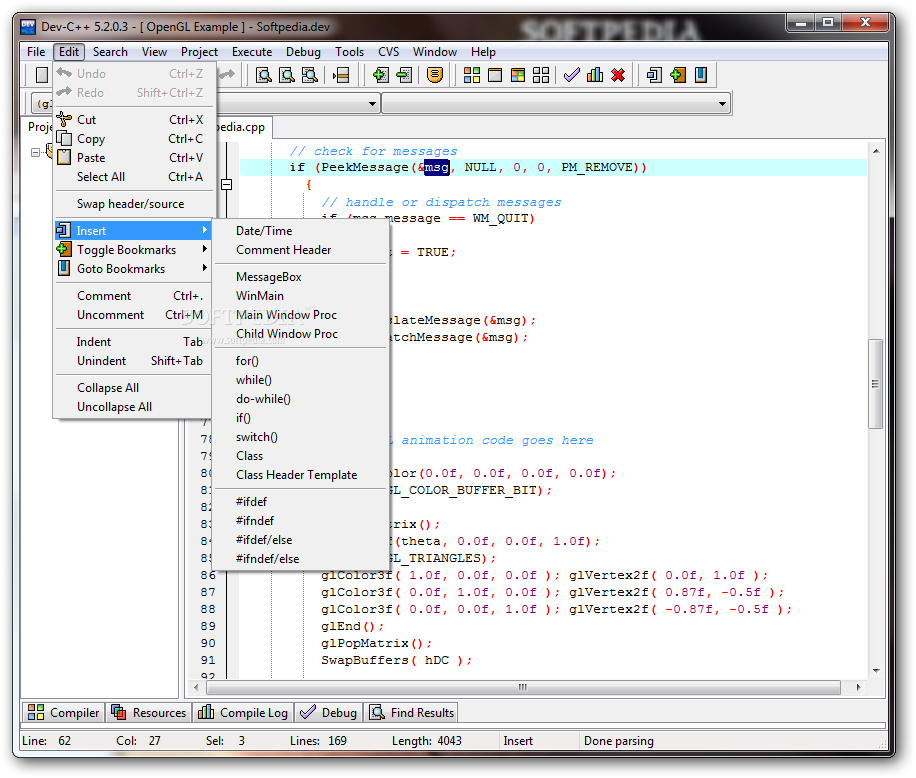File Header Dev C
- C Programming Tutorial
- C Programming useful Resources
- Selected Reading
A header file is a file with extension .h which contains C function declarations and macro definitions to be shared between several source files. There are two types of header files: the files that the programmer writes and the files that comes with your compiler.
You request to use a header file in your program by including it with the C preprocessing directive #include, like you have seen inclusion of stdio.h header file, which comes along with your compiler.
Cpp Header Files
Including a header file is equal to copying the content of the header file but we do not do it because it will be error-prone and it is not a good idea to copy the content of a header file in the source files, especially if we have multiple source files in a program.
The comments (and, to an extent, code) should look like only one person has worked on the file. If you're starting a new project, pick one style format and stick with it. Places to start looking: Google style guides (C, JavaScript, Objective-C, and Python) Oracle JavaDoc comment example. Apr 02, 2016 Home » Borland/Dev C » Mengenal File Header dan Fungsinya pada C Mengenal File Header dan Fungsinya pada C. Unknown 7 comments. Pada bahasa pemrograman C,dibutuhkan file header agar dapat mengakses memori.File header adalah file yang berisi deklarasi,baik berupa konstanta,standard input output,maupun sebagai syntax. Apr 08, 2015 I have used graphics.h in dev cpp. Though I can't remember the exact steps I used to include it, but I think the below answer is correct. Source: How to configure graphics.h in Dev-C You can easily solve this problem, DEV-C do support gra. A C source file (for instance, myProgram1.c) in the File Manager, the Dev-C program window will open automatically. The few lines of code that appear in the center are the default templates. This is a C template. To change it to C template replace the first line of the code with #include.
A simple practice in C or C++ programs is that we keep all the constants, macros, system wide global variables, and function prototypes in the header files and include that header file wherever it is required.
Include Syntax
Both the user and the system header files are included using the preprocessing directive #include. It has the following two forms −
This form is used for system header files. It searches for a file named 'file' in a standard list of system directories. You can prepend directories to this list with the -I option while compiling your source code.
This form is used for header files of your own program. It searches for a file named 'file' in the directory containing the current file. You can prepend directories to this list with the -I option while compiling your source code.
Include Operation
The #include directive works by directing the C preprocessor to scan the specified file as input before continuing with the rest of the current source file. The output from the preprocessor contains the output already generated, followed by the output resulting from the included file, followed by the output that comes from the text after the #include directive. For example, if you have a header file header.h as follows −
and a main program called program.c that uses the header file, like this −
the compiler will see the same token stream as it would if program.c read.
Once-Only Headers

Header Files In C Language
If a header file happens to be included twice, the compiler will process its contents twice and it will result in an error. The standard way to prevent this is to enclose the entire real contents of the file in a conditional, like this −
This construct is commonly known as a wrapper #ifndef. When the header is included again, the conditional will be false, because HEADER_FILE is defined. The preprocessor will skip over the entire contents of the file, and the compiler will not see it twice.
Download C Header Files
Computed Includes
Sometimes it is necessary to select one of the several different header files to be included into your program. For instance, they might specify configuration parameters to be used on different sorts of operating systems. You could do this with a series of conditionals as follows −
Add Header File In Dev C++
But as it grows, it becomes tedious, instead the preprocessor offers the ability to use a macro for the header name. This is called a computed include. Instead of writing a header name as the direct argument of #include, you simply put a macro name there −
Gotoxy Header File In Dev C++
SYSTEM_H will be expanded, and the preprocessor will look for system_1.h as if the #include had been written that way originally. SYSTEM_H could be defined by your Makefile with a -D option.